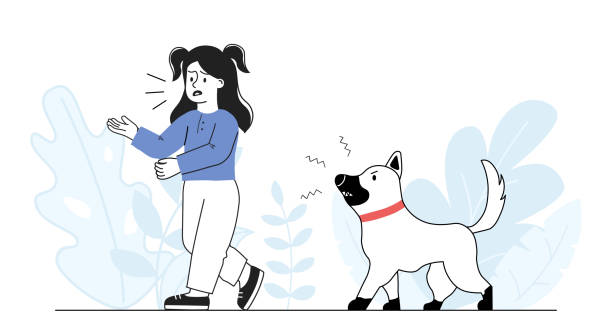
Training Mistakes That Make Pets Anxious — And How to Avoid Them
Discover the most common training mistakes that increase anxiety in pets, learn expert-backed strategies to avoid them, and create a calm, confident, and happy companion through effective, compassionate training techniques.
🐶 Pet Star
31 min read · 3, Jul 2025

Introduction: Understanding the Link Between Training and Pet Anxiety
Training is an essential part of responsible pet ownership, fostering good behavior, safety, and strong bonds. However, when done improperly, training can inadvertently cause anxiety and stress in pets. This article explores common training mistakes that lead to anxious behaviors in dogs and cats, why they happen, and how to avoid them using humane and effective methods. By understanding your pet’s emotional world, you can transform training into a positive experience that promotes calmness and confidence rather than fear.
The Psychology of Pet Anxiety: Why Training Matters
What Is Pet Anxiety?
Pet anxiety refers to feelings of stress, fear, or nervousness in response to certain stimuli or situations. Like humans, pets can suffer from generalized anxiety, situational anxiety, or specific phobias.
How Training Influences Anxiety
Training is not just about teaching commands; it’s a communication tool between pet and owner. When training methods are harsh, inconsistent, or poorly timed, they can increase a pet’s stress levels, erode trust, and trigger anxious behaviors such as trembling, hiding, barking, or destructive habits.
Neurobiology Behind Anxiety in Pets
Studies reveal that chronic stress elevates cortisol levels, impairing learning and memory. An anxious pet struggles to focus and absorb new commands, creating a vicious cycle where training failures lead to more anxiety.
Common Training Mistakes That Cause Anxiety
1. Using Punishment-Based Techniques
Why It Backfires
Punishments like shouting, leash jerks, or shock collars may suppress unwanted behavior temporarily but often increase fear and stress. Pets may become anxious about anticipating pain or negative consequences.
Expert Insight
Dr. Patricia McConnell, a renowned animal behaviorist, states, “Punishment-based training erodes the human-animal bond and often leads to aggression or anxiety-related problems.”
2. Inconsistent Commands and Expectations
The Confusion Factor
Inconsistency in commands, rules, or training schedules creates confusion. Pets do not understand what is expected, leading to frustration and anxiety.
Real-World Example
A dog that is allowed on the couch one day but scolded the next will experience conflicting signals, making it harder to relax and trust their owner.
3. Overwhelming Your Pet With Long Sessions
Fatigue and Stress
Training sessions that are too long or too intense can overwhelm your pet, causing them to shut down or exhibit anxious behaviors.
Statistic
A 2021 study in the Journal of Applied Animal Behavior found that sessions longer than 15 minutes significantly reduced focus and increased stress indicators in dogs.
4. Ignoring Your Pet’s Body Language
Missing the Signs
Not recognizing signs of stress such as yawning, lip licking, or avoiding eye contact can lead to pushing a pet beyond their comfort zone.
Importance of Timing
Training should be paused or adjusted when a pet shows signs of anxiety to avoid negative associations.
5. Lack of Positive Reinforcement
Why Reward Matters
Ignoring positive behaviors or not rewarding promptly undermines motivation. Pets need to associate training with good outcomes to feel safe and confident.
Science-Backed Benefits
Positive reinforcement releases dopamine, reinforcing neural pathways linked to learning and pleasure.
How to Avoid These Mistakes: Effective Anxiety-Friendly Training Methods
1. Emphasize Positive Reinforcement
Definition and Benefits
Use treats, praise, or play to reward desired behaviors. This creates positive associations and encourages repetition.
Practical Tips
- Use high-value treats your pet loves.
- Reward immediately to link behavior and reward.
- Incorporate play or affection for additional motivation.
2. Keep Training Sessions Short and Frequent
Ideal Duration
Sessions of 5 to 10 minutes, multiple times a day, help maintain your pet’s focus and enthusiasm.
Breaks and Play
Include breaks and fun activities to keep the experience enjoyable.
3. Consistency Is Key
Unified Commands and Rules
Use the same verbal cues and signals consistently across family members.
Routine Schedules
Establish regular training times to create a predictable environment.
4. Learn to Read Your Pet’s Body Language
Stress Signals to Watch For
Recognize subtle cues like ear position, tail movement, and eye contact.
Respond Appropriately
Adjust or pause training if anxiety signs appear, resuming only when your pet is calm.
5. Create a Safe and Calm Environment
Environment Design
Choose quiet, familiar spaces free from distractions for training.
Pre-Training Calmness
Use calming scents or sounds and consider calming supplements when appropriate.
Specialized Approaches for Different Pets
Dogs: Building Confidence Through Training
Focus on Socialization
Early and gentle exposure to different environments reduces anxiety.
Use Clicker Training
Clicker training enhances precision and positive reinforcement.
Cats: Respecting Independence and Sensitivity
Patience and Choice
Let cats choose when to engage in training; forcing can heighten anxiety.
Use Target Training
Teaching cats to touch a target with their nose can encourage engagement without pressure.
Case Studies: Success Stories Avoiding Anxiety in Training
Bella’s Journey From Fearful to Confident
Bella, a rescue dog with severe separation anxiety, showed signs of stress during traditional obedience training. After switching to short, reward-based sessions focused on gradual desensitization, Bella’s anxiety reduced by 60% within three months.
Whiskers’ Transformation
Whiskers, a shy cat, became fearful during vet visits. Using gentle target training and calming pheromone sprays helped reduce stress, making Whiskers more cooperative and calm in medical environments.
How to Handle Setbacks and Anxiety Flare-Ups During Training
Recognizing Anxiety Flare-Ups
Even with the best intentions, setbacks happen. Pets may suddenly exhibit anxious behaviors during training—such as cowering, trembling, refusing to engage, or excessive panting. Recognizing these flare-ups early allows owners to adjust training before anxiety worsens.
Veterinarian behaviorist Dr. Karen Overall emphasizes, “It’s critical to monitor your pet’s emotional state closely. What may seem like stubbornness is often a cry for help or discomfort.”
Step Back and Reset
When anxiety spikes, pause training and give your pet space. Allow them to retreat to a safe, familiar area or engage in calming activities like gentle petting or quiet rest. Resetting the environment helps prevent negative associations with training.
Modify Training Plans
Adjust the difficulty and duration of sessions to better suit your pet’s emotional threshold. For instance, if a dog is anxious about meeting new people during socialization training, reduce exposure intensity by starting behind a barrier or at a distance, gradually moving closer as comfort increases.
Use Desensitization and Counter-Conditioning
These two techniques help pets unlearn fearful responses by pairing previously scary stimuli with positive experiences. For example, if your pet is scared of the leash, reward calm behavior around the leash with treats and play. Over time, anxiety diminishes.
The Impact of Owner Emotions on Pet Anxiety
Pets Mirror Their Owner’s Feelings
Pets are highly sensitive to human emotions and can pick up on subtle cues like tone of voice, body language, and stress hormones. Owners who approach training with anxiety or frustration may inadvertently transmit these feelings, making their pets more anxious.
Cultivating Calmness and Patience
Before beginning any training session, take a moment to relax and set a positive mindset. Deep breathing or short mindfulness exercises can help.
Professional trainer Victoria Stilwell notes, “Dogs respond best when their owners are calm, confident, and consistent. It’s a partnership, not a dictatorship.”
Avoid Punitive or Angry Responses
Frustration often leads to punitive reactions, which can harm the pet’s emotional well-being and damage the training relationship. Instead, use pauses and regroup strategies, and always reinforce positive behaviors.
The Role of Environment and Routine in Reducing Training Anxiety
Creating a Predictable Schedule
Pets thrive on routine. Predictability in feeding, walks, playtime, and training sessions reduces stress by providing a sense of control and security.
Studies show that pets with irregular schedules exhibit more anxiety-related behaviors, including vocalizations and destructive acts.
Safe Spaces and Comfort Zones
Designate a quiet, cozy spot in your home where your pet can retreat during and after training. This area can include a comfy bed, favorite toys, and soothing scents like lavender.
Minimizing Distractions
When training, minimize loud noises, sudden movements, or unfamiliar people around. A calm, controlled environment helps pets focus and feel secure.
Technology and Tools That Support Anxiety-Friendly Training
Interactive Toys and Treat Dispensers
Using technology like puzzle feeders or treat dispensers can engage pets mentally and reward calm, focused behavior. These tools promote problem-solving without pressure.
Wearables to Monitor Stress
Devices like Whistle or FitBark track activity levels and physiological indicators, giving owners real-time insights into stress or anxiety patterns. This data helps tailor training schedules for optimal emotional well-being.
Calming Products
- Pressure wraps or anxiety vests: Mimic the feeling of being hugged, which calms many pets.
- Pheromone diffusers: Synthetic pheromones like Adaptil and Feliway reduce anxiety by signaling safety.
- Calming supplements: Consult your vet about natural remedies like CBD oil or L-theanine.
Common Misconceptions About Training and Anxiety
Myth: “Dominance-Based Training Works Best”
Dominance theory is outdated and often harmful. Using intimidation or physical dominance fosters fear, not respect.
Myth: “Anxiety Means My Pet Is ‘Bad’”
Anxiety is a medical and behavioral issue, not a moral failing. Punishing anxious pets only worsens their condition.
Myth: “More Training Means Better Behavior”
Overtraining or forcing sessions without regard to emotional state causes burnout and anxiety.
Conclusion
Training your pet is much more than teaching commands—it’s about building trust, communication, and emotional security. When training methods are harsh, inconsistent, or neglectful of your pet’s emotional signals, anxiety can develop and undermine both behavior and wellbeing. This anxiety can manifest as fearfulness, aggression, withdrawal, or other stress-related behaviors, making training even more challenging.
By avoiding common mistakes such as punishment-based techniques, overwhelming sessions, and ignoring body language, you create a positive training environment that fosters confidence and calmness. Emphasizing positive reinforcement, consistency, short sessions, and respecting your pet’s individual temperament transforms training into a rewarding and anxiety-free experience for both you and your companion.
Remember, pets are highly sensitive to their owners’ emotions. Your calm, patient, and compassionate approach will greatly influence your pet’s comfort and willingness to learn. Using appropriate tools, recognizing when to adjust or pause, and seeking professional help when necessary are vital steps toward success.
Ultimately, anxiety-friendly training enriches your pet’s quality of life, strengthens your bond, and helps them thrive in your family. Whether you have a dog, cat, or another companion, understanding and prioritizing your pet’s emotional needs during training is the key to long-term happiness and behavioral success.
Q&A Section
Q1: What is the main cause of anxiety during pet training?
A: Anxiety often results from punishment, inconsistency, or overwhelming training sessions that fail to consider the pet’s emotional state.
Q2: How can positive reinforcement reduce training anxiety?
A: Positive reinforcement rewards good behavior, builds trust, and creates enjoyable learning experiences, which reduce fear and stress.
Q3: How long should training sessions last to avoid anxiety?
A: Sessions should generally last 5 to 10 minutes to maintain focus and prevent fatigue or overwhelm.
Q4: Why is reading a pet’s body language important during training?
A: It helps detect signs of stress early, allowing owners to adjust training before anxiety escalates.
Q5: Can all pets benefit from the same training methods?
A: No, training should be tailored to individual temperament, breed tendencies, and species-specific needs.
Q6: How does owner emotion affect a pet’s anxiety?
A: Pets often mirror their owner’s stress or calmness, so a calm, patient owner helps reduce pet anxiety.
Q7: Are punishment-based training methods effective?
A: While they may suppress behavior temporarily, they often increase anxiety and damage the human-animal bond.
Q8: When should I seek professional help for my pet’s anxiety?
A: If anxiety persists despite training adjustments or worsens, consulting a certified trainer or behaviorist is recommended.
Q9: What environmental factors can reduce training-related anxiety?
A: Predictable routines, quiet training spaces, and designated safe zones help create a calming environment.
Q10: How can socialization prevent anxiety in pets?
A: Early, gradual exposure to people, animals, and environments builds confidence and reduces fear-based anxiety later in life.
Similar Articles
Find more relatable content in similar Articles

The Growing Trend of Therapy and Emotional Support Ani..
Exploring the remarkable rise .. Read More

How Pets Strengthen Family Bonds...
Pets are more than just compan.. Read More

Pets and Mental Health: The Science Behind Emotional H..
Discover the profound impact o.. Read More

How Climate Change Affects Wild and Domestic Animals...
Climate change is dramatically.. Read More
Explore Other Categories
© 2024 Copyrights by rPets. All Rights Reserved.